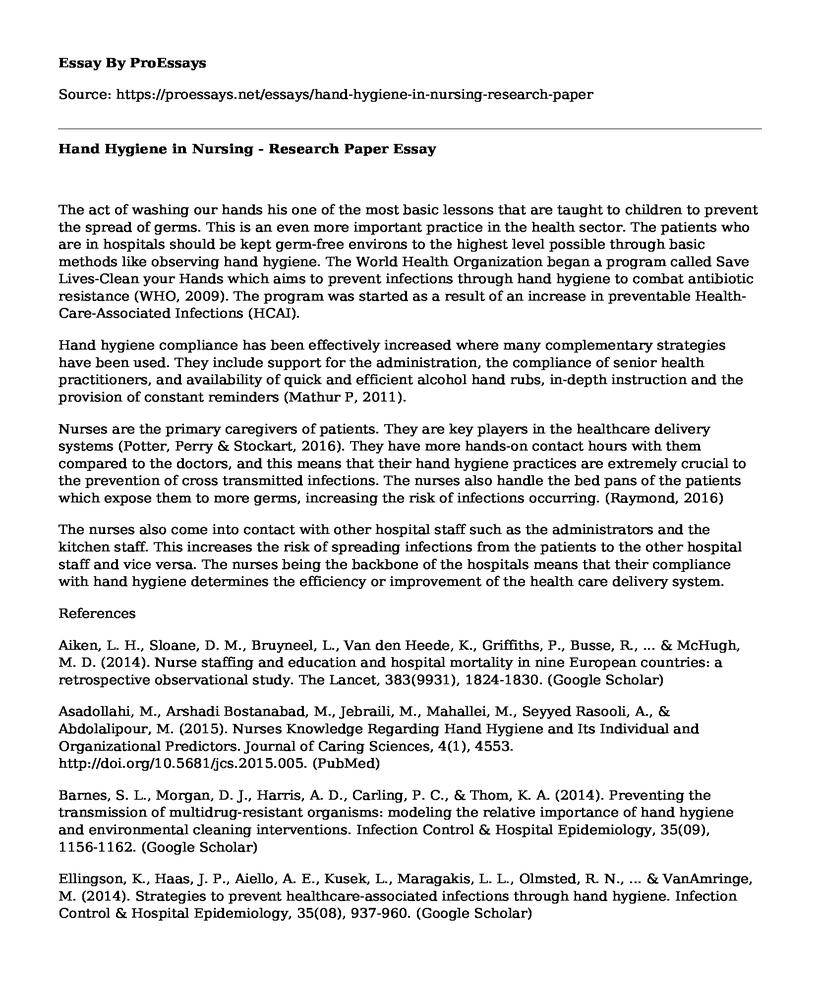The act of washing our hands his one of the most basic lessons that are taught to children to prevent the spread of germs. This is an even more important practice in the health sector. The patients who are in hospitals should be kept germ-free environs to the highest level possible through basic methods like observing hand hygiene. The World Health Organization began a program called Save Lives-Clean your Hands which aims to prevent infections through hand hygiene to combat antibiotic resistance (WHO, 2009). The program was started as a result of an increase in preventable Health-Care-Associated Infections (HCAI).
Hand hygiene compliance has been effectively increased where many complementary strategies have been used. They include support for the administration, the compliance of senior health practitioners, and availability of quick and efficient alcohol hand rubs, in-depth instruction and the provision of constant reminders (Mathur P, 2011).
Nurses are the primary caregivers of patients. They are key players in the healthcare delivery systems (Potter, Perry & Stockart, 2016). They have more hands-on contact hours with them compared to the doctors, and this means that their hand hygiene practices are extremely crucial to the prevention of cross transmitted infections. The nurses also handle the bed pans of the patients which expose them to more germs, increasing the risk of infections occurring. (Raymond, 2016)
The nurses also come into contact with other hospital staff such as the administrators and the kitchen staff. This increases the risk of spreading infections from the patients to the other hospital staff and vice versa. The nurses being the backbone of the hospitals means that their compliance with hand hygiene determines the efficiency or improvement of the health care delivery system.
References
Aiken, L. H., Sloane, D. M., Bruyneel, L., Van den Heede, K., Griffiths, P., Busse, R., ... & McHugh, M. D. (2014). Nurse staffing and education and hospital mortality in nine European countries: a retrospective observational study. The Lancet, 383(9931), 1824-1830. (Google Scholar)
Asadollahi, M., Arshadi Bostanabad, M., Jebraili, M., Mahallei, M., Seyyed Rasooli, A., & Abdolalipour, M. (2015). Nurses Knowledge Regarding Hand Hygiene and Its Individual and Organizational Predictors. Journal of Caring Sciences, 4(1), 4553. http://doi.org/10.5681/jcs.2015.005. (PubMed)
Barnes, S. L., Morgan, D. J., Harris, A. D., Carling, P. C., & Thom, K. A. (2014). Preventing the transmission of multidrug-resistant organisms: modeling the relative importance of hand hygiene and environmental cleaning interventions. Infection Control & Hospital Epidemiology, 35(09), 1156-1162. (Google Scholar)
Ellingson, K., Haas, J. P., Aiello, A. E., Kusek, L., Maragakis, L. L., Olmsted, R. N., ... & VanAmringe, M. (2014). Strategies to prevent healthcare-associated infections through hand hygiene. Infection Control & Hospital Epidemiology, 35(08), 937-960. (Google Scholar)
Mathur P. Hand hygiene: Back to the basics of infection control. (2011). The Indian Journal of Medical Research.;134(5):611-620. doi:10.4103/0971-5916.90985. (PubMed)
Potter, P. A., Perry, A. G., Stockert, P., & Hall, A. (2016). Fundamentals of nursing. Elsevier Health Sciences. (Google Scholar)
Raymond, Linda. (2016): Importance of Preventative Hand Hygiene Practices In Community Nursing Wound Management. Australian Nursing and Midwifery Journal: ANJ; Melbourne24.2 32. (Proquest)
Sickbert-Bennett, E. E., DiBiase, L. M., Willis, T. M. S., Wolak, E. S., Weber, D. J., & Rutala, W. A. (2016). Reduction of Healthcare-Associated Infections by Exceeding High Compliance with Hand Hygiene Practices. Emerging Infectious Diseases, 22(9), 1628. (Google Scholar)
Sharif, A., Arbabisarjou, A., Balouchi, A., Ahmadidarrehsima, S., & Kashani, H. H. (2016). Knowledge, Attitude, and Performance of Nurses toward Hand Hygiene in Hospitals. Global Journal of Health Science, 8(8), 5765. http://doi.org/10.5539/gjhs.v8n8p57. (PubMed)
World Health Organization. 2009. WHO guidelines on hand hygiene in Health Care. ISBN 9789241597906 (Google Scholar)
Cite this page
Hand Hygiene in Nursing - Research Paper. (2021, Apr 12). Retrieved from https://proessays.net/essays/hand-hygiene-in-nursing-research-paper
If you are the original author of this essay and no longer wish to have it published on the ProEssays website, please click below to request its removal:
- Benefits of Membership in the Nurse Practitioner Alliance of Alabama
- 5 Weeks Graduation Nurse Reflection - Essay Example
- Essay Sample on Health Care Cost and Quality
- Medical Technology Essay
- Essay Example on Diabetes: Type 1 and Type 2 Overview
- Essay Example on Accelerating Clinical Coding Technologies in Healthcare Industry
- Differences in COPD Care: Hospital vs. Home Preferences & Satisfaction Essay Example







